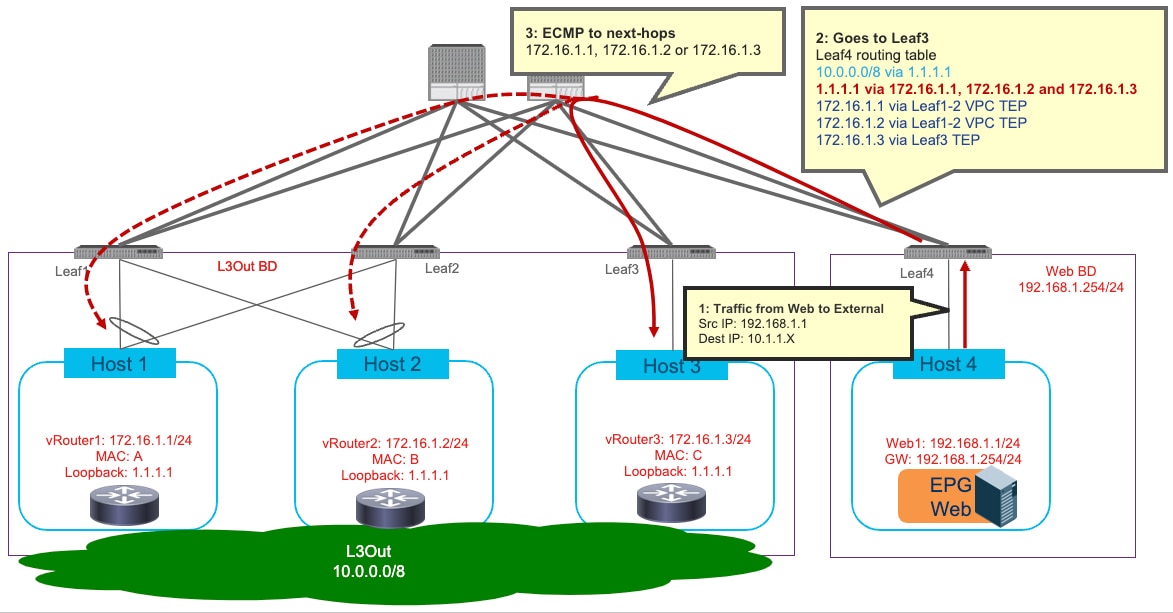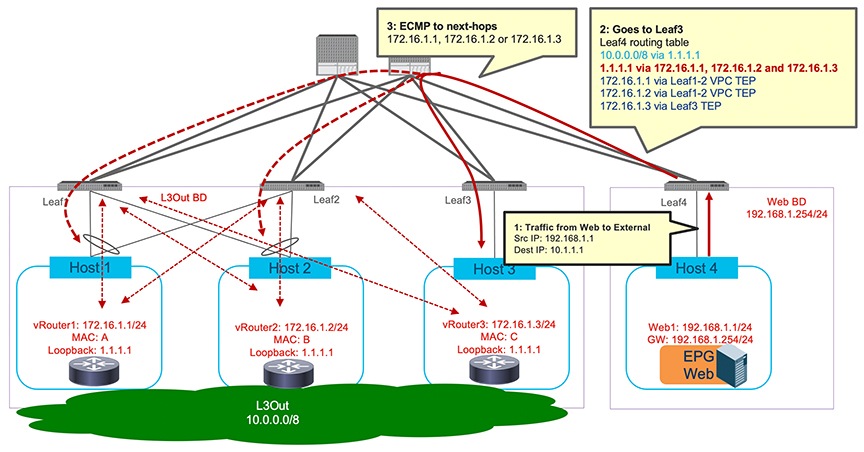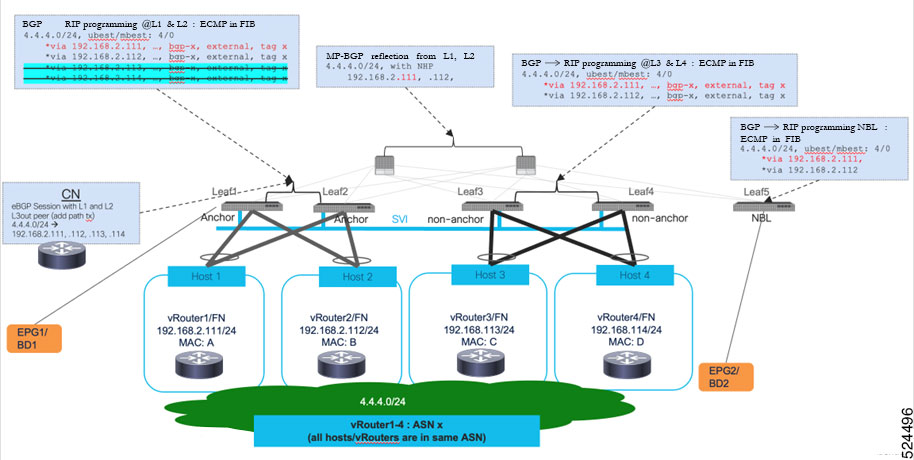Avoiding Suboptimal Traffic From a Cisco ACI Internal Endpoint to a Floating L3Out

Beginning with Cisco ACI release 5.0(1), you can avoid this outbound suboptimal traffic path behavior by configuring the following two features:
-
Next-hop propagation: this configuration is applied only to the anchor leaf nodes and enables them to redistribute the external prefixes inside the Cisco ACI fabric with the next-hop IP address of the external router announcing these external prefixes. That way, the compute leaf nodes (as Leaf4 in the example in Advertisement of External Prefixes with Next-Hop Propagation Enabled) receive and install in their forwarding tables the external prefixes with the external router's IP address as the next-hop (10.0.0.0/8 reachable using 172.16.1.1 in the example below).
-
Direct host advertisement route-control profiles: this configuration is applied on all the anchor and the non-anchor leaf nodes where the external routers are connected. It enables those leaf nodes to redistribute the directly attached host route (representing the external router's IP) inside the Cisco ACI fabric (172.16.1.1 using the Leaf3 TEP in the example below). This is critical to ensure that the compute nodes can perform a recursive lookup and send the outbound flows directly to the leaf nodes where the external routers are connected, no matter if they are anchor or non-anchor leaf nodes.
 Note |
The functionalities listed above are supported for floating L3Outs with physical domains only, not with VMM domains. |


Between Cisco ACI releases 5.0(1) to 5.2(1), you can use the functionality described above to avoid this suboptimal path when using eBGP for peering between the external devices and the anchor nodes. Starting from Cisco ACI release 5.2(1), avoiding this suboptimal path is also supported when using OSPF for peering or even with static routing.
As of Cisco ACI Release 6.0(2), the outbound traffic optimization functionality described above is supported for intra-VRF traffic only. Inter-VRF traffic where the consumer and the provider are in different VRFs is not supported. This consideration is applied to both EPG to external EPG and external EPG to external EPG contracts.
Although the example above uses a single external device for peering with the anchor leaf nodes and forwarding traffic from/to the external network domain, the use of different external devices is also possible. ECMP for external prefixes when deploying multiple external routers with OSPF or static route illustrates an example using OSPF or static route, and Lack of ECMP for external prefixes when deploying multiple external routers with BGP illustrates an example using BGP. Each external device can establish routing peering with the anchor leaf nodes to propagate external prefix information into the fabric.


When BGP is used to learn the same external prefix, even if each external router advertises the same external prefixes (10.0.0.0/8, in this example), the compute leaf nodes receiving them only install a single next-hop for each prefix. In other words, it is not possible to leverage ECMP for reaching the same external prefix. This restriction is due to the fact that, as of Cisco ACI release 6.0(1) and in the specific case of Cisco ACI floating L3Out deployments, only one IP address can be installed on the Cisco ACI leaf nodes as external next-hop to reach a prefix learned using BGP. This consideration is applicable to both IPv4 and IPv6.
 Note |
As shown in the figure above, a single path to the external prefix is installed on the compute leaf node. This is not the case for the anchor leaf nodes, where all the paths to the external prefix received by the external routers can be successfully installed. |
A possible solution to benefit from ECMP for reaching external prefixes consists of deploying the same loopback IP address on all the forwarder nodes so that the following can happen:
-
All the external routers can advertise a specific external prefix to the anchor leaf nodes via BGP using the same address (the IP address of the loopback interface) as next-hop for the prefix.
-
The anchor leaf nodes receives the external prefix and performs two functions:
-
Redistribute the external prefix information into the ACI fabric, with a single next-hop represented by the common loopback IP address configured on each external router.
-
Redistribute the common loopback IP address into the ACI fabric, with next-hops the IP addresses of the external routers part of the directly connected L3Out SVIs subnet. This information must be learned on the anchor nodes via OSPF adjacencies established with the external routers or configured via static routes.
-
A compute leaf node receiving the control plane information described above from the anchor nodes can then leverage the "Recursive Route Resolution" feature introduced in Cisco ACI release 5.2(1) to benefit of ECMP for outbound flows destined to the external prefix. This behavior will be discussed in greater detail in the next section: Support for Multi-Protocol Recursive Route Resolutions.







 Feedback
Feedback